[TAKK...]
March 25, 2013 09:30
This year, cherry blossoms were in full bloom in various parts of Tokyo earlier than usual.
Around Tsukuda Island, where the Sumida River branches off from the Harumi Canal, there are many cherry blossom viewing spots in parks on the super embankment.
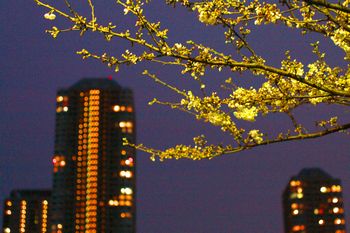
At night, in addition to the illuminated cherry blossoms, you can enjoy the waterside scenery of the lights of buildings, ships passing through the Sumida River, and shining bridges.
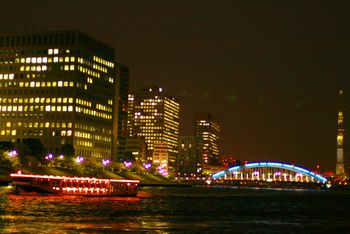
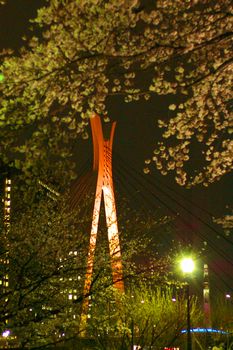
The monument at the site of the Ishikawajima Lighthouse in Tsukuda Park is also lit.
It imitates a nightlight built in 1886 by Junji Shimizu, a magistrate of Hitoshishoba.
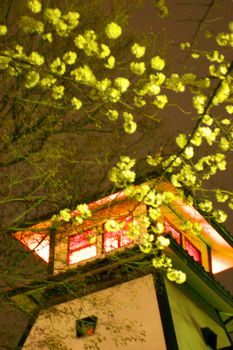
You can see the Sky Tree in the upper reaches of the Sumida River.
At this time, "Sakura Special Lighting" was held, and it was colored with two types of light-ups, "Saki" and "Mai", which were switched every 15 minutes.
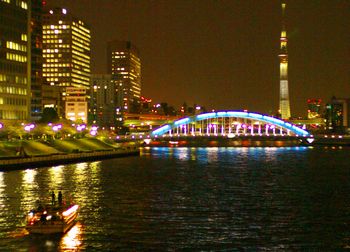
Every year, the cherry blossoms, which welcome people who start a new life in Tokyo in April, will fall off the people who leave Tokyo in March this year?
[Silver]
March 22, 2013 14:00
With the "Guide Map of Kazuo Confectionery Association in Chuo-ku", we are purchasing representative products of each shop.  At that time, a shop sells "broken rice crackers", and the bag says "Kusuke".
At that time, a shop sells "broken rice crackers", and the bag says "Kusuke".
Hey, I knew that "I call a broken rice cracker called Kusuke."  Speaking of which, I remembered that I learned such a thing from Kyoba Peony. According to the dictionary, Hisa is the same pronunciation Q. →
Speaking of which, I remembered that I learned such a thing from Kyoba Peony. According to the dictionary, Hisa is the same pronunciation Q. →  It means that one is not enough for the perfect 10, so it is called this, and it is said that it is an industry word mainly used in the rice crackers industry. It's stylish!
It means that one is not enough for the perfect 10, so it is called this, and it is said that it is an industry word mainly used in the rice crackers industry. It's stylish!
The "Guide map of Kazuo Chuo-ku Confectionery Association", which I always bring when I go out, is very useful. There are 38 merchants, so far we have visited 20 stores, put their receipts on a map, and used them as stamp cards. It's very fun.  How would you like to join us? In addition, the guide map of the Kazuo Confectionery Association in Chuo-ku can be obtained at the stores of each member store. For more information, please refer to this guide from "NPO Chuo Net". http://www.tokyochuo.net/sightseeing/wagashi/index.html
How would you like to join us? In addition, the guide map of the Kazuo Confectionery Association in Chuo-ku can be obtained at the stores of each member store. For more information, please refer to this guide from "NPO Chuo Net". http://www.tokyochuo.net/sightseeing/wagashi/index.html
[Mr.Chuo-ku]
March 19, 2013 08:35
At Harumi Triton Square , a program named "Tsutomu Night" is held on the third Thursday of each month or irregularly. The other day, I was able to participate in this "Night Tsutomu" and spend a meaningful time.
, a program named "Tsutomu Night" is held on the third Thursday of each month or irregularly. The other day, I was able to participate in this "Night Tsutomu" and spend a meaningful time.
↓Click to enlarge

-thumb-200x64-12117.jpg)
The guide in the figure above states, "We will support the business life of those who work at Harumi Triton Square!", But those who are not working at Harumi Triton Square can also participate.  Participation is free.
Participation is free.
(It seems that it would be better to make a reservation early because it will be full soon.)
Contents of 2013 held (quoted from the PDF file of the guide)↓
- Thursday, January 17 “How to Create a Global Career” Lecturer: Yoko Ishikura Professor, Graduate School of Media Design, Keio University
- Thursday, February 21 "First Impression of Success" Lecturer: Miyuki Shigeta Impression critic and impression trainer
- Tuesday, March 17 “The essential subject for businessmen is“ How to prepare mind ”” Lecturer: Kenichiro Mogi Brain Scientist
Harumi Triton Square Official Website
http://www.harumi-triton.jp/
In addition to this "Night Tsutomu", "Harumi Walking Rally"  and various workshops
and various workshops are held.
are held.
http://www.harumi-triton.jp/events/
Access
Train, city bus, car:
http://www.harumi-triton.jp/access/
Harumi Liner (bus):
http://www.hitachi-gr.com/o_info/HARUMIliner.html
[Sam]
March 2, 2013 09:00

 They are said to have a tendency to live inland rivers and lakes inland, live inland during the dayseagull, and go down the river in the evening to go out to the sea and roost offshore.
They are said to have a tendency to live inland rivers and lakes inland, live inland during the dayseagull, and go down the river in the evening to go out to the sea and roost offshore.
The legs and beaks are red, the winter feathers have a white head, and dark spots are behind the eyes. Some individuals were changing to summer feathers like wearing black hoods. (top right of the photo)
Basically, it feeds fish and crustacean, but depending on the environment, it eats insects and weeds seeds, and is said to be omnivorous.
A high and muddy voice.
Until the spring departure time, you can enjoy the swarm of Japanese plums on the banks around the Sumida River.









-thumb-200x64-12117.jpg)

